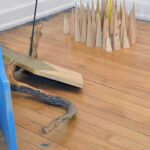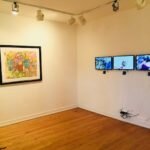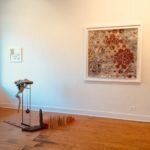STRIKE/SLIP: John Grod, Stacy Isenbarger, Harold Jeffries and Jennifer Mannebach
March 11 – April 14, 2018
Guest curated by Jennifer Mannebach
Guest curator walkthrough and artist’s talk with Jennifer Mannebach and John Grod takes place Saturday, April 14, 2-3pm
Guest Curator’s Statement:
STRIKE/SLIP brings together the work of John Grod, Stacy Isenbarger, Harold Jeffries and Jennifer Mannebach–artists who share a deep interest in borders and boundaries. What is the condition of existing at a border or threshold? Whether it’s a geographical area or a philosophical point of view, to inhabit a headspace while simultaneously empathizing with someone else, one or the other must be slightly blurred. ‘Around,’ ‘Between,’ ‘Within,’ ‘Delineate’ and ‘Across’ are words that, as Stacy Isenbarger once said, “draw us to an edge, but more importantly our need to define it in reflection to our place in confronting it. We shift.”
The tectonic implications of STRIKE/SLIP, a type of fault line where the ground shifts horizontally in an earthquake, are especially resonant in this context. I’ve asked three other artists who have these proclivities to join me in this exhibit. Working with Harold Jeffries is particularly freighted with these concerns. Although I have worked with him professionally at Little City Center for the Arts as a facilitator for his singular work, he is also a friend and collaborator. While the content of his work is already rich with polarities and borderlines (heaven/earth, real/imagined), there is also the circumstance of Jeffries’ everyday interactions with people. Jeffries’ spoken communication is often discursive and fragmented, and I believe this kind of collaboration could only happen authentically within the context of longstanding friendship and trust. Jeffries’ empathy and generosity of spirit are asserted through his deep concern about the housing needs of all people, on earth and elsewhere. His drawings, or “blueprints for heaven,” are designs for something yet to be built; they are mutable and in the moment, but reflect a concrete intention.
The relationship between John Grod, Jeffries and me as we collaborate contains thresholds that are vacillating, only becoming more legible through a longer arc of time. Grod has a persistent and tenacious pursuit of expanding creative possibilities through video; more than just a facilitator, he is able to harness his own formidable creative and technical skills to collaborate in a way that gives others a voice but also reflects his own distinct sensibilities. His choice of labor intensive processes reveal his empathy and dogged pursuit of these ideals. Stacy Isenbarger’s work invites closer inspection while never allowing for a comfortable place to settle. Superannuated upholstery and padded surfaces imply domesticity and comfort, but also insinuate questionable issues of decorum or even subterfuge. New and old structures and notions of inside/out dichotomies are underscored by the absurdity of a velvet covered rock or stick. Thoughts turn to mutations, a transmutation of nature and culture as well as private/public implications. It is not so much about marking the contours, but rather, exploring possibilities in that liminal space. –Jennifer Mannebach
Artists’ Statements:
Jennifer Mannebach, artist, guest curator:
I’ve always been interested in remnants, mistakes, awkward encounters. In past work,
I’ve explored the shifting ground of casual moments between people. My most recent
body of work explores the boundaries and architecture around, between and within
people. Inspired by city maps, honeybee navigation charts and human genome maps,
my references also extend into tracking methods of larger group identities, conflating the
boundaries of the body with geographic boundaries, underscoring the inauthenticity of
maps that can never tell a complete story and the reduction of an individual to a genetic
map. A housing map of Chicago was the catalyst for Vouchers, which also references
illuminated manuscripts, a grand contrast to the important stories swept under the rug in
anonymous representations of people’s lives. In recent work, my use of paper
emphasizes these tectonic shifts in the transition between areas that are cut and
sanded, placed comfortably, and sections that are applied more in the tradition of
marquetry, revealing a seam rather than overlap.
Stacy Isenbarger:
Detached from expected presentations, my work is empowered by cultural associations
to materials, language, and iconography. Poetic intersections at play create dialectical,
contextual space for viewers to experience. As viewers perceive their place in relation to
these suggested boundaries and directives, they can reflect on their own ability to
navigate the complexities of our restrictive environments. This outside dynamic
highlights the shortcomings of labeling and dividing lines of cultural, spiritual, and
political judgment. Through this philosophically charged space, viewers are asked to
challenge their assumptions of their environment and the restrictive barriers they build
for themselves.
Harold Jeffries:
Harold’s empathy and generosity of spirit are asserted through his deep concern about
the housing needs of all people, on earth and in heaven. Harold’s drawings or
“blueprints for heaven” are designs for something yet to be built, yet paradoxically they
are mutable and in the moment. They seem constantly renewable, the desire to create
an ideal fixed home a guiding principal, perhaps to remedy the transiency of his abusive
and unstable childhood. Though physically manifested in singular drawings, these plans
are a lifelong project with no beginning, middle or end.
John Grod:
Formerly the Little City Center for the Arts Media Arts Manager, John received a degree in fine arts from The University of Illinois at Chicago and went on to work at The Center for New Television; a non-profit media arts center for ten years. There he conducted workshops in video production and post-production as well as being the on-line editor for “The 90’s”, a nationally syndicated PBS magazine style show that won numerous awards. He has served as a freelance independent video consultant, editor and production assistant for numerous award-winning productions. He maintains a strong commitment to educate and counteract mainstream media’s marginalization of those on society’s fringes. Grod has won over 30 awards for media programs produced at Little City. In 2013 he directed Share My Kingdom, which premiered at the Gene Siskel Film Center and has been featured in various film festivals since then.























